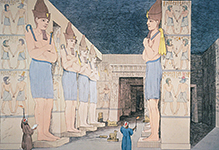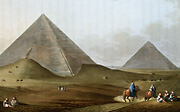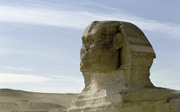
Egypt
Birth and Death,Cult and Gods,Pharaos and Officials,Pyramids and Temples,Daily Life.

#08011913
The God Amun-Ra (with tall plumes in his crown) embraces Pharaoh Tuthmos...

#08011914
The Falcon-god Horus points the ankh, sign of life, towards Ramses II,who we...

#08011915
Gods Onuris and Mehyt confirm the royal prerogatives of Pharaoh Ramses II, wh...

#08011916
Flask.Such vessels were made by immersing a matrix in molten glass, a techn...

#08011917
Monkeys from the base of the second obelisk of Ramses II's temple in Lu...

#08011918
Pharaoh Sebekhotep IV (13th dynasty, around 1725 BCE). Granite (weighing 5 tons...

#08011919
Goddess, Middle or New Kingdom (2033-1069 BCE) Bronze, black patina,ful...

#08011920
God Besh as a pot for storing khol, the eyeliner of the Egyptians. End...

#08011921
Two statues of the lion-goddess Sekhmet,from the Mut-temple in Karnak,Egy...

#08011922
Four statues of the lion-goddess Sekhmet,from the Mut-temple in Karnak,bui...

#08011923
The Lady Pakhetemmat (12th dynasty, around 1900 BCE). From her tomb at Antinoe...

#08011924
Unidentified mummy with 'cartonnage' covering. The technique,used since...

